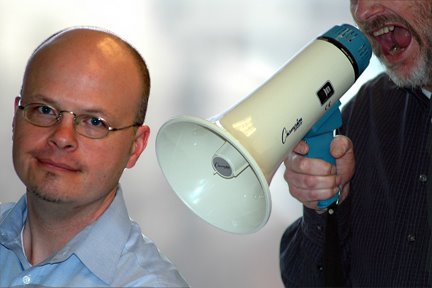Preaching Is Part of H Street’s Character
 (CLICK TO ENLARGE) Rev. Dallas Williams of Baltimore, Md., gains satisfaction from ministering on the street, which he admits is most effective without an amplifier. Residents of 8th Street NE support street preaching in the H Street NE corridor’s free marketplace of ideas—just not with a blaring, peace-disturbing amplifier. (Copyright © 2006. David Klavitter)
(CLICK TO ENLARGE) Rev. Dallas Williams of Baltimore, Md., gains satisfaction from ministering on the street, which he admits is most effective without an amplifier. Residents of 8th Street NE support street preaching in the H Street NE corridor’s free marketplace of ideas—just not with a blaring, peace-disturbing amplifier. (Copyright © 2006. David Klavitter)H Street NE enjoys a rich history of street preaching, a legacy confirmed by 80-year-old Rev. Dallas Williams of Baltimore, Md. I encountered him as he preached from 3-5 p.m. at the southwest corner of H and 8th Street NE on Sunday, July 9. I remember Williams at the same spot several years ago, but I hadn’t seen him since.
His use of an amplifier on a quiet Sunday afternoon first rousted me from my studies at home. Williams was very approachable and polite. He put down the microphone as I introduced myself.
His amplifier pointed northeast toward H Street. I explained how the community is disturbed by the amplified sound. Williams apologized for the noise, and added that it’s more effective to talk to people without using the amplifier. “I want to first get the attention of people exiting the buses,” he said. His amplifier was quiet for the rest of the afternoon.
Williams said he is drawn to the intersection by the four busy bus stops at the H and 8th Streets NE. In the 1960s, he frequently preached on H Street. He rotated from one corner to the next—from 4th to 15th Street NE.
He continues to derive satisfaction from ministering on the street, but said it’s much more challenging these days. “People need to be entertained,” said Williams. “You have to have the gift of gab.”
Williams said he was greatly influenced by a book called “The Cross and the Switchblade,” by David Wilkerson. It’s a story about Wilkerson’s first five years in New York City, ministering to gang members during the early 1960s. “I highly recommend you read that book,” said Williams.
 When he was younger, Williams and several other preachers traveled between Baltimore, Washington, New York, Chicago and Atlanta. At one time they owned three buildings in northwest D.C. and three buildings in Baltimore, he added. Together they spread God’s word to faraway places like India and Africa.
When he was younger, Williams and several other preachers traveled between Baltimore, Washington, New York, Chicago and Atlanta. At one time they owned three buildings in northwest D.C. and three buildings in Baltimore, he added. Together they spread God’s word to faraway places like India and Africa.Williams said his wife died several years ago. He tries to keep busy by preaching when he can scrape enough money together to buy gas for his car. I gave him my phone number and asked him to lunch or dinner during his next visit to H Street.


5 Comments:
Nice post, again making it perfectly clear that it's the noise, not the proselytizing, that is the problem!
Wow. Great photo. That could win an art award. You should submit it.
Cheers,
Brian
David, thanks for your approach to this. I don't agree with the others message, but support free speech as well. I happen to agree with this man's message, so I'm glad to hear that he is respectful in his approach. Regardless, thanks for keeping the issue what it is: Noise polution - not free speech.
Again, thanks for your perspective on this issue, it's very refreshing. Joel Schmidgall (NE Resident)
Thanks, Joel. Yes, we all support free speech. A decibel meter can easily and without bias measure noise.
A car amplifier will give you a loud and clear sound on a consistent basis. It will boost the power flowing from the
receiver to the speakers. In doing so, it will reduce the stress put on all the other components of your car stereo
system, including the receiver.
Choosing the right car amplifier is important. Your decision should be based on five important features. Make sure you
address them all !
The first item on the agenda is the number of channels. This will depend on the number of speakers in your system.
Two-channel amplifiers will feed well two speakers or a single subwoofer. You will want to consider a four-channel
amplifier if you have any of the following combinations :
Post a Comment
<< Home